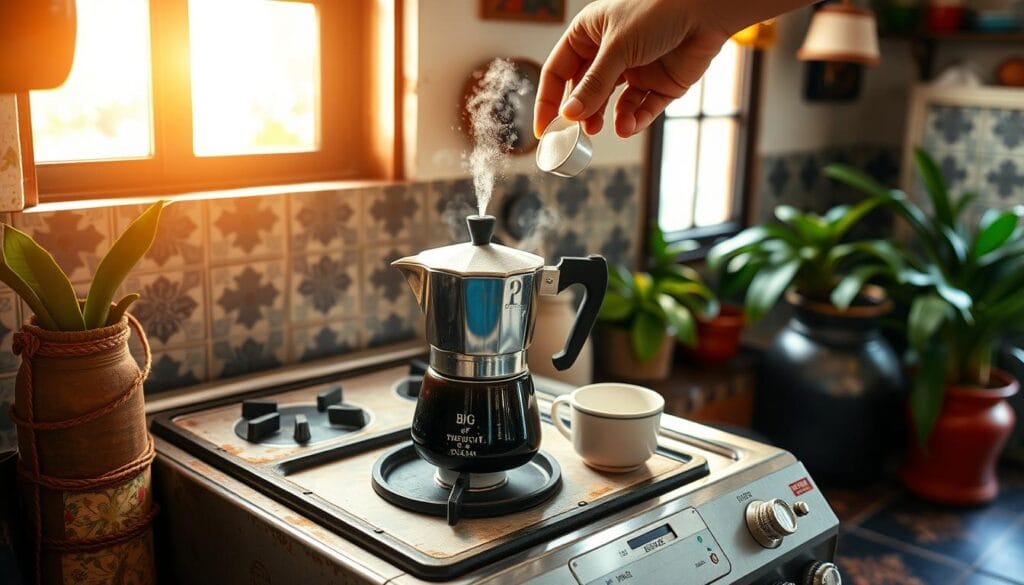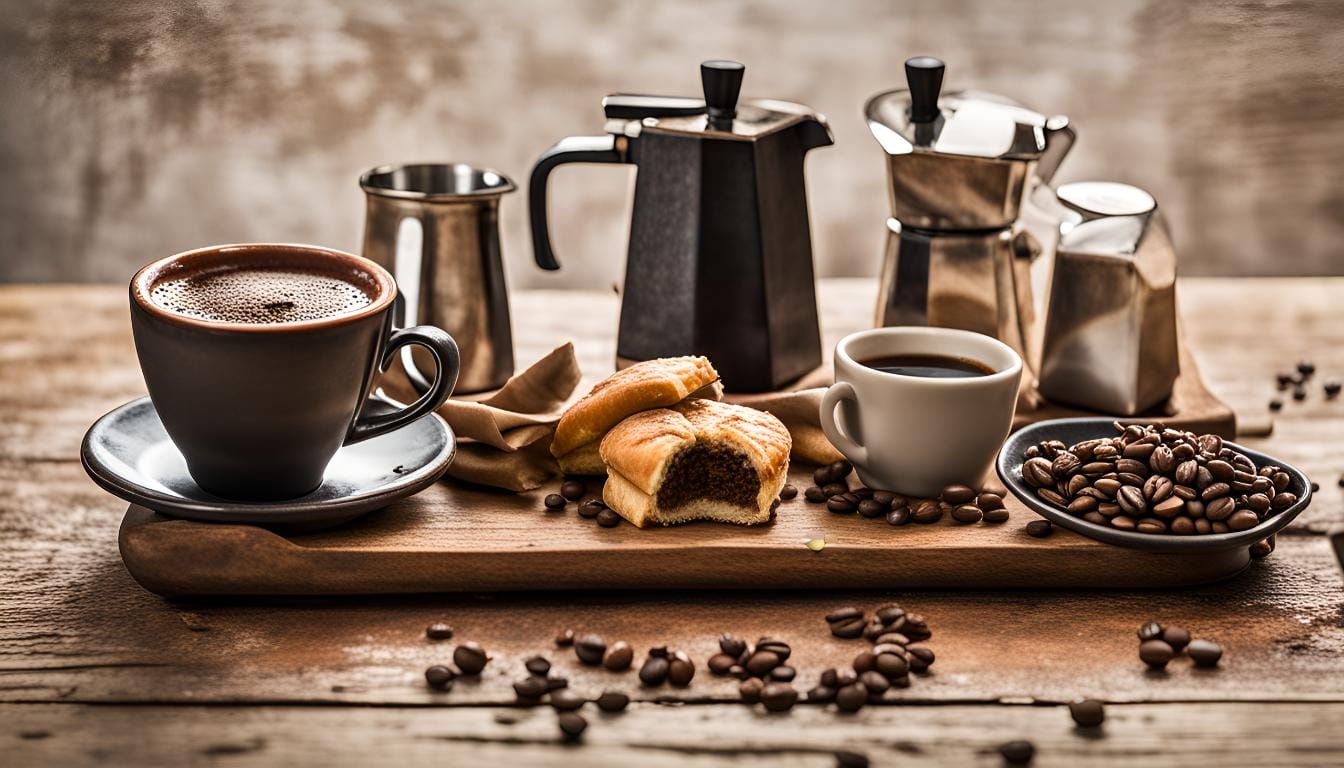Understanding the Difference Between Cuban Coffee and Cafecito: How to Make Cuban Coffee Perfectly
Did you know Cubans drink more coffee than anyone else in the world? This highlights how central coffee is to Cuban life. If you’re wondering how to make Cuban coffee, the key is the Cuban coffee, or ‘cafecito,’ a strong espresso drink made in a special way.
Cafecito is different from regular espresso. The main difference is the sweet foam, called “espuma,” made by mixing coffee with sugar. This, along with a moka pot and special coffee like La Llave Cubano or Bustelo, makes a drink known for its bold taste and smooth feel. It’s also very important in Cuban culture.

Table of Contents
Key Takeaways
- Cafecito, or Cuban coffee, is a unique espresso-based drink with a distinctive preparation method
- It involves creating a sweet foam called “espuma” by mixing the first few drops of brewed coffee with sugar
- Cafecito is made using a moka pot, finely ground Latin coffee brands like La Llave Cubano or Bustelo, sugar, and water
- The drink is known for its strong flavor, sweet taste, and deep cultural significance in Cuban society
- Cafecito differs from a standard espresso in its preparation and the creation of the espuma
Understanding Cuban Coffee Culture and Heritage
Cuban coffee has a long history, starting in the 18th century. Back then, Cuba was a big sugar producer. Cuban style coffee quickly became popular among locals. Today, cuban cafecito is a big part of Cuban life, bringing people together.
Origins of Cuban Coffee Tradition
In 1748, José Antonio Gelabert brought coffee to Cuba from the Dominican Republic. Coffee grew fast, thanks to Cuba’s soil and climate. Soon, cuban style coffee was a big part of daily life and social events.
Cultural Significance in Cuban Society
In Cuba, cuban cafecito is more than coffee. It’s about welcoming friends, showing friendship, and feeling part of a community. Enjoying a cup of cuban style coffee is a special moment, whether it’s at breakfast, a break, or an evening.
The Role of Coffee in Cuban Social Life
Preparing and sharing cuban cafecito is key in Cuban social life. Cubans drink many cups a day, often with toasted bread. This tradition helps build strong relationships and a sense of belonging.
The story of Cuban coffee is fascinating. From its start to today, coffee is deeply connected to Cubans. This heritage shapes their daily lives and is a symbol of their identity, both at home and abroad.
Key Ingredients and Equipment for Authentic Cuban Coffee
Making the perfect cafe cubano drink needs specific ingredients and tools. At its core, Cuban coffee uses dark roast coffee beans from brands like La Llave or Bustelo. These beans give the coffee its bold, rich flavor.
Demerara sugar is also key. It adds a sweet, molasses taste and creates the creamy foam on top. For drinks like Café con Leche, milk is also important.
- Dark roast coffee beans (preferably Cuban brands like La Llave or Bustelo)
- Demerara sugar
- Milk (for certain Cuban coffee drinks)
The moka pot is crucial for brewing Cuban coffee. It’s a stovetop espresso maker that extracts flavors slowly. The colador, a Cuban coffee sock, is also vital for brewing.
Demitasse cups are the best for serving Cuban coffee. They keep the coffee’s intensity and add to the enjoyment of the drink.
“The ritual of preparing and enjoying a Cuban coffee is as much a part of the culture as the coffee itself.”
How to Make Cuban Coffee: Step-by-Step Guide
Making the perfect Cuban coffee is like an art. It mixes tradition, skill, and a bit of magic. Whether you love coffee or are new to Cuban-style, learning to make it is very rewarding. Here’s how to make a real Cuban-style coffee at home.
Preparing the Moka Pot
The base of Cuban coffee is the Moka pot. First, fill the bottom with cold water, just below the valve. Then, pack the filter basket with dark-roast coffee. Make sure the coffee is spread out well for the best flavor.
Creating the Perfect Espumita
As the coffee brews, pour a bit into another container. Add a lot of sugar and mix until it’s thick and creamy, like wet sand. This is the espumita, a key part of Cuban coffee.
Achieving the Right Consistency
After the coffee is done, mix it with the espumita. The goal is to balance the sugar’s sweetness with the coffee’s flavor. You can adjust the sugar and coffee to your liking, adding more sugar for sweetness or coffee for strength.
Getting good at Cuban coffee takes time, but it’s worth it. With practice and care, you can make a coffee that truly captures Cuban culture and tradition.
The Art of Creating Cuban Cafecito
Making a true Cuban cafecito is more than just brewing coffee. It’s a skillful art that needs precision to get the perfect cafe cubano drink. This drink combines strong espresso with creamy, sweet espumita foam.
The espumita’s creation is crucial for a great Cuban cafecito. It starts with mixing the first espresso drops with 1 to 1 ½ tablespoons of sugar. This mixture is then whipped until it becomes a thick, creamy foam.
Today, some prefer a less sweet version, using 1–2 teaspoons of sugar. But, the traditional Cuban coffee uses 1–1 ½ tablespoons of sugar for the right sweetness.
After making the espumita, it’s mixed with the espresso. This creates a perfect blend of strong coffee and sweet foam. The result is a Cuban cafecito that’s both refreshing and indulgent, showcasing Cuba’s rich coffee culture.
| Brands Associated with Cuban Coffee Beans | Typical Sugar Quantity per Espresso Shot | Modern Sugar Preference |
|---|---|---|
| Bustelo, Pilon, La Llave | 1 to 1 ½ tablespoons (15–22 mL) | 1–2 teaspoons (5–10 mL) |
“Cuban coffee is not just a beverage, it’s a cultural tradition that has been passed down through generations. The perfect Cuban cafecito is a work of art, a delicate balance of bitter espresso and sweet, creamy foam.”
Different Variations of Cuban Coffee Drinks
Cuban coffee culture is rich and diverse, with many unique coffee drinks. Each one has its own flavor and cultural importance. This gives coffee lovers a wide range of choices to enjoy.
Café Con Leche
Café con leche is a classic Cuban coffee. It mixes strong espresso with steamed milk. It’s perfect for breakfast, offering a creamy and balanced taste.
The amount of milk to espresso can be adjusted. This makes the coffee and milk blend harmonious.
Cortadito
The cortadito is a smaller version of café con leche. It has an equal mix of espresso and steamed milk. The name “cortadito” means “cut” or “shortened” in Spanish.
This drink is creamier and sweeter than traditional Cuban coffee. It’s a delightful twist on the classic.
Colada
A colada is a large Cuban coffee, served in a styrofoam cup. It comes with smaller plastic cups on the side. It’s meant for sharing with friends and family.
The colada is strong and aromatic. It offers a concentrated and high-caffeine experience.
These Cuban coffee variations show the creativity and cultural value of Cuban coffee. Whether you like café con leche, cortadito, or colada, there’s a Cuban coffee for everyone. It’s a way to enjoy the rich traditions of Cuban cuisine and hospitality.
| Variation | Ingredients | Preparation | Characteristics |
|---|---|---|---|
| Café Con Leche | Espresso, Steamed Milk | Combine hot espresso and steamed milk in a cup | Creamy, Well-Balanced Flavor |
| Cortadito | Espresso, Steamed Milk | Mix equal parts espresso and steamed milk | Creamier, Slightly Sweeter Taste |
| Colada | Strong Espresso | Serve in a styrofoam cup with smaller plastic cups | Robust, High-Caffeine Experience |
Cuban cuban style coffee is known for its bold flavor and cultural importance. The different Cuban coffee drinks, like café con leche, cortadito, and colada, each have unique tastes and preparation methods. Understanding these nuances can deepen your appreciation for the how much caffeine in cuban coffee and its role in Cuban society.
Common Mistakes to Avoid When Making Cuban Coffee
Making the perfect Cuban coffee or Cuban cafecito needs careful attention. Stay away from these common mistakes to get a true and tasty flavor.
First, choose the right coffee beans. Dark roast, finely ground coffee is key for Cuban coffee’s deep flavor. Arabica beans from brands like Bustelo, Pilon, and La Llave are the best choice.
Next, watch the sugar-to-coffee ratio. Traditionally, use 1 to 1½ tablespoons of sugar for each espresso shot. Nowadays, many like 1-2 tsp of sugar for a lighter taste.
- Using too much coffee or water in the moka pot makes the coffee weak.
- Getting the espumita (sugary foam) right is crucial. Too much or too little coffee can mess up its texture.
- Not mixing the espumita well with the coffee can make the flavor uneven.
Avoid these mistakes and learn the traditional ways to make a great Cuban coffee. You’ll enjoy a truly authentic and delicious Cuban coffee experience.

Conclusion
Cuban coffee has a rich history and unique ways of making it. It offers a distinct and flavorful coffee experience. From the traditional cafecito to variations like café con leche and cortadito, Cuban coffee culture is all about the drink and the social moments it brings.
By learning about the key ingredients, equipment, and techniques for cuban style coffee, you can make it at home. This way, you can enjoy the cultural staple anytime.
The cafe cubano drink is loved as a morning pick-me-up or at social gatherings. It’s a beloved part of Cuban heritage and a growing trend worldwide. Each sip takes you to Cuba’s sunny shores and lively streets, celebrating coffee-making art and honoring traditions.
In the end, Cuban coffee is a unique and flavorful experience that highlights the Caribbean’s rich culture. By mastering Cuban coffee-making, you can add a vibrant tradition to your daily life. This connects you to the heart of Cuban coffee culture.
Source Links
- How To Make Cuban Coffee (Café Cubano) – https://asassyspoon.com/how-to-make-cuban-coffee/
- Cuban Coffee Culture How to Make Authentic Cuban Coffee – JavaPresse Coffee Company – https://www.javapresse.com/blogs/enjoying-coffee/cuban-coffee-culture-how-to-make-authentic-cuban-coffee
- Café Cubano: A Cuban Cultural Staple – https://silenciocoffeeco.com/blogs/history/cafe-cubano-a-cuban-cultural-staple
- Echoes of Havana – The Intriguing Tale of Café Cubano – https://www.luxcafeclub.com/blogs/news/echoes-of-havana-the-intriguing-tale-of-cafe-cubano?srsltid=AfmBOoosUExt3AWx3rhdKuUZPoefRYSxmDvCpM-v3nVMmYcZFJwjcoDY
- What’s in Café Cubano? – https://zwarteroes.nl/en-int/blogs/koffie-feiten/wat-zit-er-in-cafe-cubano
- How To Make Cuban Coffee: Authentic Cafecito Recipe – https://www.homegrounds.co/how-to-make-cuban-coffee/
- How To Make Cuban Coffee (Café Cubano): Step-By-Step Guide – https://coffeevoila.com/how-to-make-cuban-coffee/
- The Art of Making Cuban Coffee: Tips , History, Culture, & Caffeine Insights – Grind Those Beans – https://grindthosebeans.com/cuban-coffee-recipe-tips-culture-caffeine/
- How To Make a Cortadito At Home (Step-By-Step Recipe) – https://coffeevoila.com/how-to-make-a-cortadito/
- How to Make Cuban Coffee: 12 Steps (with Pictures) – wikiHow – https://www.wikihow.com/Make-Cuban-Coffee
- Easy and Delicious: Authentic Cuban Cortadito Coffee Recipe – https://addjoi.com/blogs/made-with-joi-recipes/easy-and-delicious-authentic-cuban-cortadito-coffee-recipe
- Master the Art of Cuban Coffee: Guide for Coffee Fanatics – https://www.redber.co.uk/blogs/blog/master-the-art-of-cuban-coffee-today?srsltid=AfmBOoqYMUJaG6SppAD5NKdYjZ3Bab6WdkSWLMlCfLBpgZcdgUtiNhlV
- How To Make Café Con Leche: The Easy Recipe (With Pictures) | Corner Coffee Store – https://cornercoffeestore.com/how-to-make-cafe-con-leche/
- Coffee Recipes from the Caribbean | Caribbean News – https://caribbeantrading.com/best-coffee-recipes-from-the-caribbean/?srsltid=AfmBOor6-3TyOXaaj0ltgb9Hvk6SOsGJspi0YdZaaikEWnSf5HcQt-IN







